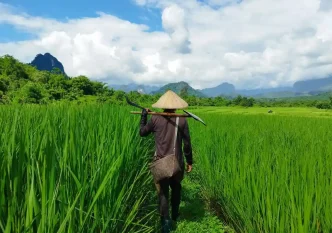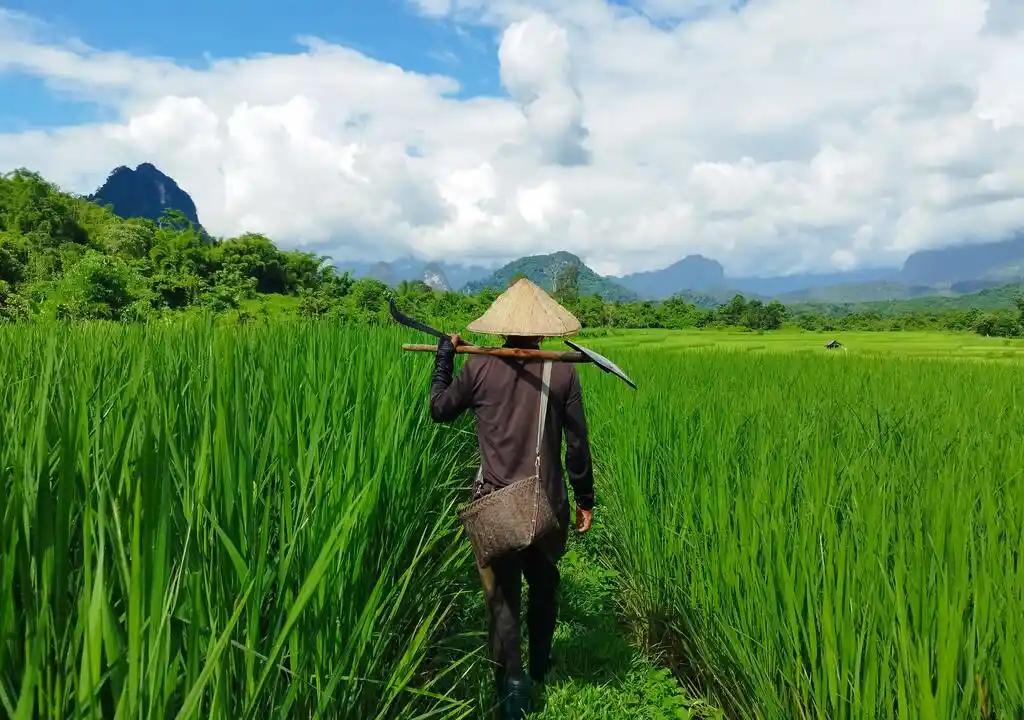In a significant step toward aligning economic growth with environmental responsibility, the Lao government, in collaboration with the United Nations system and supported by the Luxembourg government, has launched a pioneering green and climate finance programme. Unveiled in Vientiane on May 2, 2025, this initiative seeks to transform Laos’s development trajectory by prioritizing sustainability, resilience, and inclusivity at a pivotal moment in the nation’s history. As Laos approaches its anticipated graduation from Least Developed Country (LDC) status in 2026, the programme underscores a commitment to balancing progress with the protection of its natural resources.
A Strategic Partnership for a Greener Future
The formal agreement for the programme was signed by Deputy Minister of Planning and Investment, Mrs Phonevanh Outhavong, and the United Nations Resident Coordinator in Laos, Mr Bakhodir Burkhanov, during the launch event. This two-year initiative, rooted in the financing strategy of Laos’s 9th National Socio-Economic Development Plan (NSEDP), aims to embed green and climate-focused mechanisms into the country’s economic framework. With the 9th NSEDP concluding in 2025 and the 10th plan set to commence in 2026, the timing of this programme is critical.
Mrs Phonevanh emphasized the urgency of aligning national financing strategies with environmental goals. “As 2025 marks the final year of our 9th National Socio-Economic Development Plan, we stand at a crucial juncture, transitioning into the 10th NSEDP with anticipated Least Developed Country graduation in 2026 – the inaugural year of our new plan” she said. She further noted that the programme addresses a key challenge by supporting “the shift towards green and climate-resilient financing mechanisms that can sustain our development gains while safeguarding our environmental assets.”
Mr Burkhanov echoed this sentiment, highlighting the global context of the initiative. “In a world of intertwined crises, we must decouple growth from environmental harm. This joint programme, as our first pooled fund prototype, drives coordinated, strategic action for a greener future” he stated. Representing the Luxembourg Embassy to Laos, Mr Thomas Lammar expressed pride in backing the effort, noting that it “not only addresses environmental sustainability but also promotes social inclusion and economic opportunity.”
Multi-Agency Collaboration and Targeted Reforms
Led by the Ministry of Planning and Investment and coordinated by the UN Resident Coordinator, the programme brings together expertise from multiple UN agencies, including the United Nations Development Programme (UNDP), the United Nations Environment Programme (UNEP), the Food and Agriculture Organisation (FAO), and the United Nations Human Settlements Programme (UN-Habitat). These agencies are working alongside key Lao ministries, such as Finance, Natural Resources and Environment, Agriculture and Forestry, Energy and Mines, as well as the Bank of the Lao PDR, to build capacity for financing environmental and climate goals.
Each agency plays a distinct role in driving systemic change. UNDP focuses on policy development and institutional reform, particularly in the extractive sector, biodiversity finance, and integrating green finance across government bodies. UNEP is tasked with advancing sustainable budgeting and fiscal reforms to ensure environmental considerations are embedded in financial sector policies. FAO bridges the gap between agriculture, environment, and finance, promoting initiatives like the national Payment for Environmental Services mechanism, climate-smart agriculture, and sustainable food systems. Meanwhile, UN-Habitat collaborates with municipal authorities to encourage urban green investments and enhance local access to climate finance.
The programme targets a range of stakeholders, from policymakers to local communities, to implement nature-based solutions, sustainable urban planning, climate-smart agriculture, and community resilience projects. It also prioritizes strengthening data systems and regulatory frameworks to attract green investment, aligning with Laos’s broader Green Growth Strategy and Nationally Determined Contributions under the Paris Agreement.
Economic Transformation at a Turning Point
Laos’s push for sustainable development comes at a critical juncture. The country, with a population of approximately 7.5 million, has historically relied on natural resources and agriculture as economic pillars, alongside growing sectors like hydropower and tourism. However, rapid development has often come at the expense of environmental degradation, with deforestation, biodiversity loss, and vulnerability to climate change posing significant challenges. The green and climate finance programme aims to address these issues by reorienting financial flows toward projects that protect ecosystems while supporting economic growth.
The initiative’s alignment with Laos’s LDC graduation plans is particularly noteworthy. Achieving LDC graduation, expected in 2026, requires meeting specific criteria set by the United Nations, including income growth, human development indicators, and economic vulnerability. While Laos has made strides in reducing poverty and improving infrastructure, sustaining these gains in the face of climate risks remains a hurdle. By integrating green finance into its national strategy, the government hopes to build a more resilient economy that can withstand global uncertainties, from extreme weather events to fluctuating commodity prices.
Financially, the programme seeks to unlock new sources of funding for sustainable projects. While exact figures for the initiative’s budget have not been disclosed, its multi-agency structure and international backing suggest a significant investment. For context, similar UN-supported programmes in the region have mobilized millions in funding—often supplemented by private sector partnerships and innovative financing tools like green bonds. In Laos, where public budgets are constrained, such mechanisms could prove transformative. For instance, a community-led reforestation project might be funded through a Payment for Environmental Services scheme, incentivizing locals to protect forests while generating income—an approach FAO is actively developing under this programme.
Challenges and Opportunities Ahead
Despite its promise, the green and climate finance programme faces obstacles. Laos’s institutional capacity to implement complex financial reforms remains limited, with bureaucratic inefficiencies and coordination gaps between ministries often slowing progress. Additionally, while international support from entities like the UN and Luxembourg provides technical expertise and funding, ensuring local ownership of the initiative is crucial to its long-term success. Without buy-in from Lao stakeholders—ranging from rural farmers to urban planners—reforms risk becoming superficial or unsustainable.
Another concern is the balance between economic priorities and environmental goals. Laos’s reliance on resource-intensive industries, such as mining and hydropower, has fueled growth but also contributed to ecological harm. Shifting to a green economy requires not only financial tools but also a cultural and political shift—a process that could take years beyond the programme’s two-year timeline. If not carefully managed, policies aimed at sustainability could face resistance from sectors or communities dependent on traditional livelihoods.
On the opportunity side, the programme positions Laos as a potential leader in green finance within the ASEAN region. Neighboring countries like Vietnam and Thailand have also pursued climate-resilient development, but Laos’s smaller scale and strategic focus on LDC graduation could allow it to pioneer innovative models. For instance, integrating climate-smart agriculture into national policy—a key FAO objective—could serve as a blueprint for other nations with similar rural economies. Similarly, UN-Habitat’s work on urban green investments in cities like Vientiane could address the rapid urbanization challenges faced across Southeast Asia.
Global Context and Regional Implications
The launch of this programme reflects a broader global trend toward sustainable finance, driven by the urgent need to combat climate change. Under the Paris Agreement, countries worldwide have committed to reducing greenhouse gas emissions and building resilience to climate impacts. For developing nations like Laos, accessing the necessary funding to meet these goals often requires international cooperation—a reality this initiative embodies. The UN’s role as a coordinator and the Luxembourg government’s support highlight how global partnerships can bridge resource gaps, particularly for smaller economies.
Regionally, Laos’s efforts could influence its ASEAN peers. The bloc has increasingly prioritized environmental sustainability, with initiatives like the ASEAN Green Bond Standards gaining traction. By embedding green finance into its national plans, Laos contributes to this collective momentum, potentially fostering cross-border collaboration on issues like transboundary river management (notably the Mekong) and regional biodiversity protection. However, disparities in capacity and political will among ASEAN members mean that progress may be uneven, requiring tailored approaches like the one being piloted in Laos.
As the green and climate finance programme unfolds, its impact will likely be measured not just in policy outcomes but in tangible benefits for Lao communities. Whether it’s a farmer adopting climate-smart techniques or a city dweller benefiting from sustainable urban planning, the initiative’s success hinges on translating high-level strategies into on-the-ground change. For now, Laos stands at the cusp of a transformative opportunity—one that could redefine its path to development in a warming world.
















